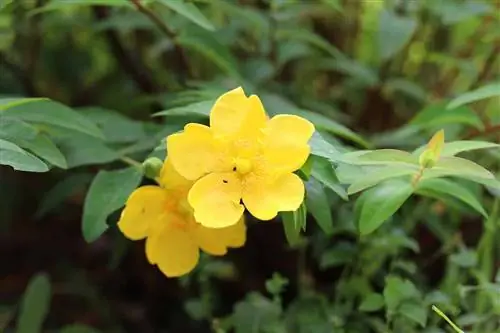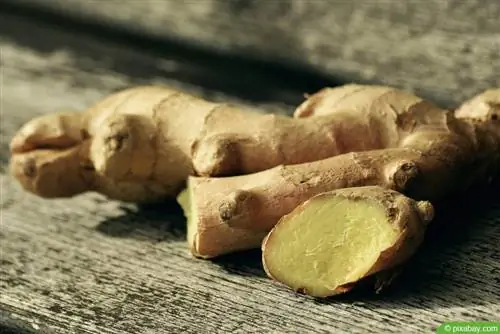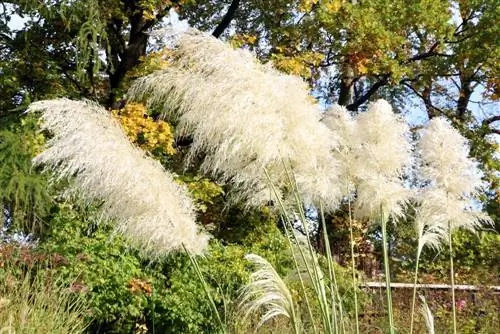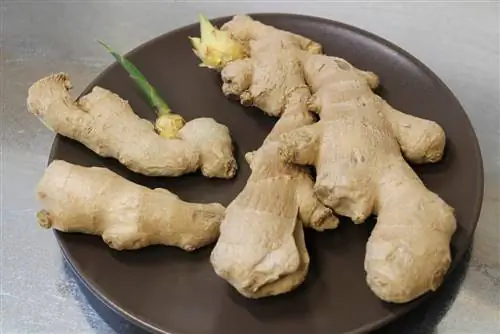- Author admin [email protected].
- Public 2023-12-17 03:39.
- Last modified 2025-01-24 12:45.
Butterfly ginger, Hedychium gardnerianum or Kahili ginger - the ornamental ginger has many names. But its tropical beauty always remains the same. Up to two meters high and covered with lush and aromatic flowers, this houseplant is an impressive sight. It becomes a highlight when the bright fruit clusters decorate its exterior in autumn. However, the exotic is not sensitive. On the contrary, with proper care, the ornamental ginger can be left outside for a while, hibernate in cold or warm weather and is also forgiving of small mistakes. But for this to happen, the culture and location have to be right. Only then will the unusual look be retained for a long time.
Location
As exotic as the ornamental ginger looks, so are its demands on the lighting conditions of its location. This should be kept as sunny as possible and should be able to offer the Hedychium gardnerianum high temperatures, at least in summer. The plant can be kept indoors all year round, but can also be taken outside from spring to autumn. The brighter and warmer the ginger plant is, the more moisture it can withstand. If the south-facing balcony is chosen as the summer location, the plant can get some rain. Dark places should be suitably dry.
Substrate
As a substrate, ornamental ginger needs nutrient-rich and loose soil that has a high mineral content. Potting soil mixed with perlite, lime or sand is suitable. Cactus soil can also be used for this. It is also important that the soil is well-drained and loose overall - meaning that waterlogging cannot occur, or at least only with great difficulty. Shards of pottery at the bottom of the pot and some coconut fiber in the substrate influence the substrate accordingly.
Pouring
How moist the ornamental ginger can be and how much needs to be watered for this purpose depends on a few factors. On the one hand, the temperature and lighting conditions at the location. The warmer and brighter it is here, the wetter the earth can be. It can also tolerate a little more water during the growth phase from April to October. During this time, the substrate should be kept as evenly moist as possible. The type of wintering also determines the frequency of watering. If the plant, which originally comes from Nepal, is still in its usual location, watering only needs to be reduced slightly. In a cool winter location, it can be almost completely adjusted.
Tip:
It is important in any case that there is no waterlogging.
Fertilize
Since the fleshy ornamental ginger can reach a height of up to two meters and develops lush flowers and immense fruit heads, it requires large amounts of nutrients. From around April to October it should therefore be supplied with liquid complete fertilizer every two weeks, which is added to the irrigation water. If Hedychium gardnerianum is placed during the winter so that it enters a dormant phase, it does not need any additional nutrients. The situation is different during warm wintering. During this time he should receive the usual fertilizer, but only every four weeks.

Tip:
Fertilizing the ornamental ginger must be combined with watering so that the roots do not suffer chemical burns.
Intersection
The ornamental ginger grows as a perennial and does not require any trimmings. Wilted flowers and ripe fruiting bodies can be removed. However, these are usually easier to break off, pluck or clip.
Repotting
The ornamental ginger does not need to be repotted regularly. It is enough to carry out this action as needed. And this is always the case when roots appear at the bottom of the flower pot or Hedychium gardnerianum is no longer stable in the container. If the butterfly ginger is already very tall, the work should not be carried out alone, but with a helper. April is ideal when a new growth phase begins. Fertilization can then be suspended for around two months as the fresh soil initially contains sufficient nutrients.
Tip:
If you thoroughly remove all the old soil from the roots, you will also eliminate any germs and pests that may be present.
Propagate
The ornamental ginger can be propagated via seeds or via the rhizome.
Seeds
If you decide to propagate using seeds, you should be prepared for a long wait and many failures. The germination rate is relatively low and cultivation requires sensitivity. This guide can help:
- The seeds are removed from the mother plant when ripe and the pulp is removed.
- In preparation for germination, they are placed in warm water for 24 hours. Older seeds that could not be germinated immediately and were stored instead are poured with hot water - i.e. brewed - and soaked in this too.
- A mixture of equal parts of potting soil and sand or perlite serves as the substrate. The seeds of the ornamental ginger are only lightly covered with it.
- The substrate is well moistened. Place the planter in a bright place at 25 °C to 30 °C.
Rhizome
Propagation via the rhizome is much easier and faster. The following description can also help here:
- When repotting the ornamental ginger, a strong piece of the rhizome, which should be about 5 cm to 7 cm long, is separated from the mother plant.
- The root piece is placed on moist soil and placed in a warm, bright place.
- Once the rhizome has begun to sprout and anchors itself in the soil, it can gradually be covered with substrate. Strong growth occurs most quickly when the young shoots are still visible slightly above the ground.
Wintering
The Kahili ginger can be overwintered either warm or cold. During warm wintering, the plant remains in its usual room or is placed in a bright, heated winter garden. The intervals between fertilizer applications are increased and watering is reduced slightly.
Nevertheless, the substrate must be kept moist. During the cold winter rest, the Hedychium gardnerianum is placed in a dark room where the temperature is at least 5 °C. Fertilizer is completely avoided here. Light watering is only done to prevent the soil from drying out completely. With this variant, it is normal for the leaves to pull back or curl up.
Typical care errors, diseases and pests
The ornamental ginger is insensitive to diseases and pests. Only errors in care can weaken it. In particular, incorrect watering behavior that leads to waterlogging or dryness can damage the plant.
Frequently asked questions
Is ornamental ginger poisonous?
All parts of the Kahili ginger are poisonous to humans and animals, which is why it should be kept out of the reach of children and playing pets.
Does Hedychium gardnerianum tolerate frost?
If the ornamental ginger is left outdoors from spring to autumn, it can be surprised by drops in temperature. If he only has to endure short frosts here, that's not a problem.
What you should know in brief
- Ornamental ginger is also known as butterfly ginger or kahila ginger.
- It can grow up to three meters high.
- Ornamental ginger can be used as a houseplant or for the winter garden.
- As a container plant, it can also be left outside during the warm months.
- In summer it produces long flower spikes with mostly large yellow flowers and red stamens that have a very pleasant scent.
- Some varieties also bloom white or pink.
Care
The homeland of ornamental ginger is in the south and southeast of Asia and Africa; 18 of the 50 species are only found in China. Since it also occurs in the Himalayas, it can tolerate slightly sub-zero temperatures, but not severe frost. Normally the foliage dies off in winter and the plant sprouts again in spring, but in warmer temperatures, for example in a winter garden, the plant can also retain its foliage. However, it shouldn't be warmer than 15° C there.
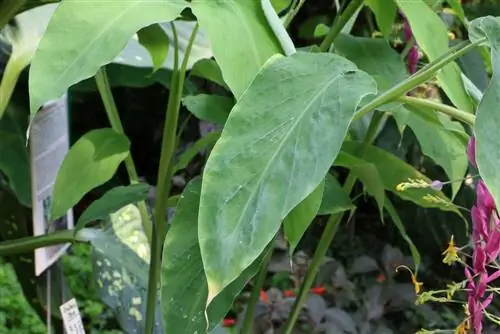
A good location for the ornamental ginger is a sunny or semi-shady place in the winter garden or on the terrace in summer. This perennial needs uniformly moist soil, but like most plants, it tolerates waterlogging poorly. A humus-rich soil that has been loosened with gravel or other coarse-grained substances is ideal. Over the course of the growing season, the ornamental ginger should be fertilized several times, then it will bloom very prolifically from August onwards and exude a somewhat sweet smell. If the ginger is in a warm location in winter, it should also be fertilized once a month.
Wintering
A potted plant should be placed in a cool and dark location to overwinter. A temperature just above 0°C is ideal. The dead leaves can be removed beforehand so that only the root ball remains. The shoots should not be trimmed. From May onwards, the plant can slowly get used to the sun again, for which it should be placed in a semi-shady place in the garden or on the terrace. Later it will be able to tolerate heat and a windy location won't bother it. It is quite insensitive to diseases and pests.



